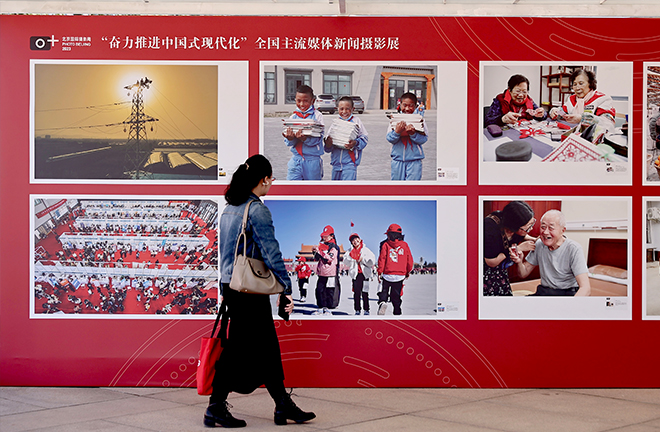China’s modernization contributes to global development

A national mainstream media photography exhibition themed “Promoting the Chinese Path to Modernization” opened in Beijing on Oct. 21. Photo: Yi Haifei/CNSphoto
Since the Industrial Revolution, world history has been influenced by industrialization and economic globalization, yet this development has not always been smooth. Certain developing countries have undergone premature deindustrialization before fully achieving industrialization, while economic globalization has encountered obstacles stemming from the tension between free trade and trade protectionism.
Global development requires diverse cultures and diversified development models. The process of modernization is inherently intertwined with global development. The Chinese path to modernization offers a new paradigm for developing countries to attain modernization and advance global development.
Modernization and global development
Global development arose from the process of modernization based on industrialization. Prior to the Industrial Revolution, global development progressed slowly. Since the Industrial Revolution initiated the modernization process in the 19th century, the world has entered a period of vigorous development, marked by unprecedented growth in human knowledge and continuous improvement in living standards.
Economic globalization, which began in the late 19th century, has advanced at an astonishing pace. Technological innovation has played a major role in this, particularly in facilitating the transfer of certain production processes to developing countries and initiating their modernization processes. This, in turn, has boosted global development, thus generating a virtuous cycle between modernization and global development.
Although global development initially arose from the modernization of developed Western countries, it is actually driven by the industrialization and modernization efforts of less developed countries as they strive to narrow the gap with leading countries. The industrialization and modernization of developed countries suggest two paths for developing nations: emulating the example of developed countries or exporting products to the expanding markets in developed countries.
Irrespective of the chosen path, developing countries are integrated into the global market, thereby fueling its expansion. The technologies, production methods, and management styles developed by more advanced countries can be quickly adopted by less developed countries with minimal risk. The latter contribute to global development while learning from developed countries to achieve their own modernization.
The rapid economic growth in developing countries drove global development after World War II. From 1950 to 1973, developing nations efficiently mobilized and allocated resources, enhanced human and material capital, and adopted relevant technologies from leading countries. This not only contributed to the ascent of East Asian economies but also reduced regional disparities in global development.
In today’s world, various global shocks underscore the fact that global development cannot be attained without the modernization of developing countries. For example, to tackle the impact of the COVID-19 pandemic, it was essential that countries jointly provide resources for necessary investments and support services in order to have sufficient funds and policy space.
Chinese path to modernization
As an important part of economic globalization, China has also contributed to global development in the process of modernization.
The rise of emerging economies including China is characterized by the adoption of development paths that align with their national conditions. These countries have not only transcended the Western model of modernization, but also addressed many development issues through their own efforts, such as poverty, employment, infrastructure construction, education quality, public health, and environmental improvement, accumulating rich domestic experience throughout the process.
Therefore, the modernization of developing countries is not only significant to their own development, but also serves as a beneficial supplement to global development. In particular, the Chinese path to modernization shows that developing countries must strive to integrate economic growth, social progress, and global development as they modernize to promote diversity of development and civilizational pluralism.
The modernization of developing countries is not simply about economic growth. It encompasses multiple dimensions, including the economy, society, politics, culture, environment and ecology, while also considering many common issues of global development. Despite the challenges encountered on the path to modernization, such as flawed economic structures, inadequate innovation drive, unbalanced development, and environmental pollution, the transformation momentum of developing countries will give impetus to global development.
The Chinese path to modernization has helped mitigate common global challenges in terms of resources, ecology, energy, and climate through a range of measures such as applying new technologies, transforming growth models, and adjusting industrial structures. Removing the obstacles to the modernization of developing countries will facilitate global green and low-carbon transformation, reduce energy security risks and fuel price volatility, and more effectively advance global development.
Diversity is one of the factors contributing to economic prosperity. Increasing tolerance and respect for differences, embracing new ideas, maintaining healthy skepticism and the courage to change the status quo are all conducive to the modernization of developing countries. The Chinese path to modernization emphasizes dialogue and consultation, joint contribution for shared benefits, win-win cooperation, exchange and mutual learning, and green and low-carbon development. Rooted in China’s development, it responds to the aspirations of developing countries for modernization, with a broader aim towards global development.
Shao Sujun and Yang Xianming (professor) are from the Development Institute at Yunnan University.
Edited by WANG YOURAN

 PRINT
PRINT CLOSE
CLOSE